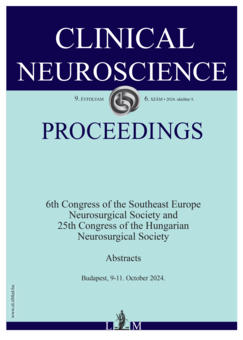[A microsurgical arteriovenous malformation model on the saphenous vessels in the rat]
MOHAMMAD W. Al-Smadi1, FAZEKAS A. László1
OCTOBER 09, 2024
Clinical Neuroscience Proceedings - 2024;9(6)
MOHAMMAD W. Al-Smadi1, FAZEKAS A. László1
OCTOBER 09, 2024
Clinical Neuroscience Proceedings - 2024;9(6)
Szöveg nagyítása:

Arteriovenous malformation (AVM) is an anomaly of blood vessel formation. Numerous models have been established to understand the nature of AVM. These models have limitations in terms of the diameter of the vessels used and the impact on the circulatory system. Our goal was to establish an AVM model that does not cause prompt and significant hemodynamic and cardiac alterations but is feasible for follow-up of the AVM’s progression. Sixteen female rats were randomly divided into sham-operated and AVM groups. In the AVM group, the saphenous vein and artery were interconnected using microsurgical techniques. The animals were followed up for 12 weeks. Hematological and hemorheological parameters were analyzed before surgery and on the 1st, 3rd, 5th, 7th, 9th, and 12th postoperative weeks. Anastomosis patency and the structural and hemodynamic changes of the heart were monitored. The hearts and vessels were histologically analyzed. During the follow-up period, shunts remained unobstructed. Systolic, diastolic, mean arterial pressure, and heart rate values slightly and nonsignificantly decreased in the AVM group. Compared to sham-operated Control group the AVM group did not show important alterations in hematological parameters nor in erythrocyte aggregation and deformability. Echocardiogram results indicated minor systolic function impact, with slight and insignificant changes in aortic pressure and blood velocity, and minimal left ventricular wall enlargement. The small-caliber saphenous AVM model does not cause acute hemodynamic changes. Moderate but progressive alterations and venous dilatation confirmed AVM-like features. The model seems to be suitable for studying further the progression, enlargement, or destabilization of AVM.
Clinical Neuroscience Proceedings
[ ]
Clinical Neuroscience
Natural disasters, such as earthquakes, frequently result in mood disorders among affected individuals. It is established that neuropathic pain arising from traumatic neuropathies is also linked to mood disorders. This study investigates the influence of neuropathic pain on the development of mood disorders in earthquake survivors with peripheral nerve injuries, following the earthquake centered in Kahramanmaraş on February 6, 2023.
Clinical Neuroscience
Long Covid is a complex condition characterised by symptoms that persist for weeks and months after the Covid infection, accompanied by cognitive impairment that negatively affects daily life. Understanding this complex condition is important for the development of diagnostic and therapeutic strategies. This article aims to provide a comprehensive overview of cognitive impairment in long-COVID.
Clinical Neuroscience
To evaluate the long-term effects of the COVID-19 pandemic on seizure frequency and levels of mental distress in individuals with epilepsy and identify potential risk factors associated with increased seizure frequency. This is a cross-sectional study conducted in Türkiye in May 2021 by phone. Information on epilepsy syndromes, antiseizure medications, average seizure frequency, and drug resistance was obtained from medical records.
Clinical Neuroscience
Airbag induced injuries such as skull and cervical spine fractures, epidural and subdural hematomas, atlantooccipital dislocations or brainstem lacerations are already documented in published literature, however, no previous case have been published about a penetrating foreign body of the skull base following airbag deployment. Removal of an intracranial foreign body is very dangerous and difficult.
Clinical Neuroscience
Although headaches are often comorbid with psychological symptoms, the underlying psychological processes, e.g. the role of personality dimensions as headache determinants remains unclear. Studies found associations between headaches and various personality traits; according to the Big Five model of personality, persons suffering from headaches exhibit a higher rate in neuroticism, while a lower rate in extraversion, openness to experiences and positive emotions.
Cervical syringomyelia associated with cervical disc disease
Comparison of pre-mortem 2D-3D ultrasound examination to post-mortem micro-CT of carotid arteries – first experiences
1.
Clinical Neuroscience
Is there any difference in mortality rates of atrial fibrillation detected before or after ischemic stroke?2.
Clinical Neuroscience
Neuropathic pain and mood disorders in earthquake survivors with peripheral nerve injuries3.
Journal of Nursing Theory and Practice
[Correlations of Sarcopenia, Frailty, Falls and Social Isolation – A Literature Review in the Light of Swedish Statistics]4.
Clinical Neuroscience
[Comparison of pain intensity measurements among patients with low-back pain]5.
Journal of Nursing Theory and Practice
[Fear of Falling among Geriatric Patients: a Narrative Review]1.
2.
3.
4.
5.